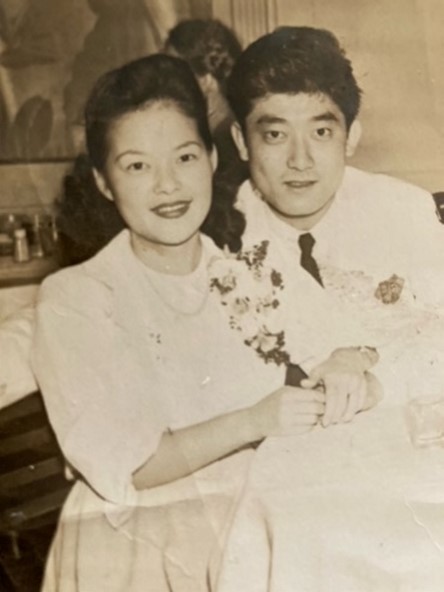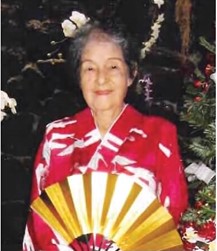
Peter Hisashi Matsukawa
Technician 5th Grade
442nd Regimental Combat Team
Service Company
Peter Hisashi Matsukawa was born on May 1, 1922, in Hilo, Hawaii island, Territory of Hawaii. He was the fifth child of Matsutaro and Tona (Nakai) Matsukawa. His siblings were: sister Mieko; and brothers Takichi, Hiroshi, Sojii (died young), and Jack Takashi.
Tona Nakai arrived on May 21, 1906, on the Korea Maru from Kumamoto Prefecture, Japan. Matsutaro emigrated from the village of Arisa, Kumamoto, in 1913. The following year, he was living at Wainaka Camp 2 in south Hilo. His parents had arrived in 1898. By 1917, Matsutaro was a salesman for the Mauna Kea Liquor Company in Hilo and living at Camp 3.
By 1930, the family lived along Aleanio Stream in south Hilo. Matsutaro worked for the sugar plantation and his widowed mother Misu lived with them. In 1940, they lived at 544 Hualili Road in Hilo. Matsutaro worked as a yardman for a private family and Tona worked on the sugar plantation.
Peter was a member of Senior Scouts Troop 30 in Hilo. On February 24-26, 1939, 28 scouts of Troop 30 climbed snow-covered Mauna Kea and reached as far as Lake Waiau. He also played on Troop 30’s basketball team. He graduated from Hilo High School the following year, 1940.
By 1942, Peter had moved to Honolulu, where on June 30 he signed his draft registration card at Local Board No. 6, located at Kawananakoa School. He was living with Yasue Matsukawa, listed as his point of contact, at 33 North Vineyard Street and employed by Hawaiian Pineapple Company on Dillingham Boulevard. He was 5’6” tall and weighed 122 pounds.
Matsukawa enlisted in the U.S. Army on March 25, 1943, in Hilo. He was sent with other enlistees to the “tent city” known as Boom Town at Schofield Barracks on Oahu. On March 28 they were given an aloha farewell ceremony at Iolani Palace. The new 442nd left on the S.S. Lurline on April 4 for Oakland, California. Upon arrival, they were sent by train across the US to Camp Shelby, Mississippi, where Peter was assigned to regimental Service Company.
After nearly a year of basic and specialized training and field maneuvers, Peter left on April 22, 1944, with the 442nd by train from Camp Shelby to Camp Patrick Henry Virginia. On May 2, they left from nearby Hampton Roads in a convoy of about 100 ships, enroute to the Theater of War.
On May 28, 1944, the 442nd arrived at Naples, Italy. They were at a nearby staging area in Bagnoli prior to boarding LSTs for the overnight trip to Anzio. Following a truck convoy around the recently liberated city of Rome, the 442nd arrived at a large bivouac area at Civitavecchia, about 60 miles north of Rome.
The 442nd, with Matsukawa, entered combat on June 26, 1944, near Suvereto, in the Rome-Arno Campaign. While in Italy, Corporal Peter H. Matsukawa was awarded his Combat Infantryman Badge.
After driving the enemy north to the Arno River, the 442nd was pulled from the lines and sent to Naples for shipment to France, where they joined in the Rhineland-Vosges Campaign. They arrived at Marseilles on September 29 after a 2-day voyage, and bivouacked at nearby Septèmes prior to traveling over 500 miles north by truck or rail boxcars to the Vosges.
Matsukawa was in combat for the next month during the bitter fighting to liberate the important rail and road junction of Bruyères, neighboring Biffontaine and Belmont, and the “Rescue of the Lost Battalion,” the 1st Battalion, 141st (Texas) Infantry that had advanced beyond the lines and was surrounded on three sides by the enemy. The weather was cold, wet, snowy, and miserable, as the men fought in the heavily wooded forests still in their summer uniforms. They were subjected to living in foxholes, and incoming artillery raining down on them in “tree bursts.”
After the fierce fighting in the Vosges, the 442nd was at half-strength, and was sent to the south of France. There, they could rebuild to full combat strength while fighting in the Rhineland-Maritime Alps Campaign, which was mostly a defensive position guarding the French-Italian border from attack by the German Army in Italy. The 442nd was there from November 23, 1944, until March 15, 1945, when they were relieved and moved in relays to the new staging area at Marseilles. On March 20-22, the 442nd (without its 522nd Field Artillery Battalion who were sent to fight the Nazis in Germany) left France to fight in the Po Valley Campaign for the final push to defeat the Nazis in Italy. They arrived at the Peninsular Base Section in Pisa on March 25 and were assigned to Fifth Army.
The objective of the 442nd was to execute a surprise diversionary attack on the western anchor of the German Gothic Line. This elaborate system of fortifications had been attacked in the fall of 1944, but no one had yet been able to pry the Germans loose from the western end. The Gothic Line in this area was hewn out of solid rock, reinforced with concrete, and constructed to give all-around protection and observation. The Germans were dug into mountain peaks rising almost sheer from the coastal plain, bare of vegetation save for scanty scrub growth.
The Combat Team left their initial staging area and moved to a bivouac at San Martino, near the walled city of Lucca. Starting on April 3, the 442nd conducted a surprise attack on the Germans at Mount Folgorito. By April 6 the 2nd Battalion had gained the ridge of Mount Folgorito and was poised for an attack on Mount Carchio and Mount Belvedere to the north, the peak that looked down on the city of Massa. By noon, F Company had reduced Mount Carchio while the rest of the 2nd Battalion began working on the wide, rolling top of Mount Belvedere, which was defended by the veteran troops of the crack Machine Gun Battalion Kesselring. The enemy battered the 442nd attackers with a steady stream of mortar fire, to no avail, and were defeated.
After these battles, the 442nd moved farther north, finally taking Aulla on April 25, penetrating as far north as Torino. The 442nd’s diversionary attack was relentlessly pursued by the Combat Team, resulting in a complete breakthrough of the Gothic Line in the west. Despite orders from Hitler to fight on, the German forces in Italy surrendered on May 2, 1945, a week before the rest of the German forces in Europe surrendered.
Matsukawa was with the 442nd while in occupation at Ghedi Airport guarding and processing German prisoners, the move to Lecco, and the return to the Livorno/Pisa/Florence area on July 12. He returned to Hawaii after serving during the occupation of Italy and was discharged at an Army Separation Center on Oahu on December 21, 1945.
For his World War II service, Tec/5 Peter Hisashi Matsukawa was awarded the following: Bronze Star Medal, Good Conduct Medal, European-African-Middle Eastern Campaign Medal with four bronze stars, World War II Victory Medal, Army of Occupation Medal, Distinguished Unit Badge, and Combat Infantryman Badge. He was posthumously awarded the Congressional Gold Medal on October 5, 2010, along with the other veterans of the 100th/442nd Regimental Combat Team. This is the highest Congressional Civilian Medal.

On March 2, 1946, Peter married Elsie Mitsume Kobayashi, daughter of Masaru and Tamayo Kobayashi of Honolulu. They settled in Manoa Housing at 2915 Kolowalu Street and over the years raised a family of twin sons and one daughter.
Peter and Elsie’s wedding photo
Peter worked as a Hawaii field investigator for the U.S. Department of Labor’s Division of Wages, Hours, and Public Contracts.

Elsie Matsukawa circa 1960s
Peter Matsukawa died on August 30, 1977, in Honolulu. He was buried at Diamond Head Memorial Park on September 2, in Section Pp-72-H. He was survived by his widow and three children. His daughter died in 2015.
On July 25, 2017, Elsie Matsukawa died and was buried next to her husband. They are survived by two sons, two grandsons, and one granddaughter.
His brother Hiroshi Matsukawa served in the 100th Battalion, A Company and was killed in action.
Researched and written by the Sons & Daughters of the 442nd Regimental Combat Team with assistance by the family in 2023.
